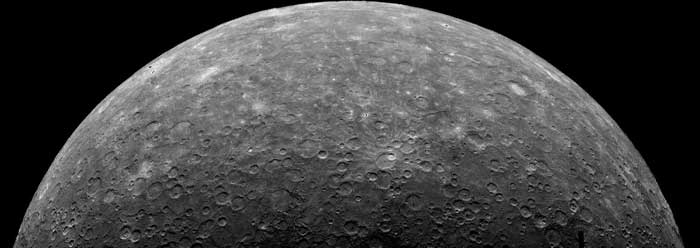Creation scientist D. Russell Humphreys described his model and its predictions in the Creation Research Society Quarterly (CRSQ), writing that someday scientists would discover remanent magnetization in Mercury's crustal rocks. He wrote, "Older igneous rocks from Mercury or Mars should have natural remanent magnetization, as the Moon's rocks do."4
"Remanent" refers to lingering magnetism. Mercury's volcanic crustal rock captured some of that planetary magnetism when it cooled and solidified into what is today a northern volcanic plain. According to Humphreys' creation model, planetary magnetic fields were strongest immediately after they were created from water about 6,000 years ago, and their strength has diminished since. How well did his prediction match the new observation 28 years later?
The space probe's magnetometer analyzed volcanic crustal rock magnetism over Mercury's northern regions. The results were presented at the 43rd Lunar and Planetary Science Conference in March 2012. An international team of planetary scientists analyzed MESSENGER's magnetic data and found that Mercury had a "residual magnetic field" that was very likely "a remanent magnetization acquired during a period when Mercury's magnetic field was of the opposite polarity, and possibly stronger, than the present field."5
In an online forum for creation scientists, CRSnet, Humphreys wrote, "I'm happy about this crustal magnetization because it fulfills yet another prediction in my 1984 CRSQ article on planetary magnetic fields. The Mars part of that got fulfilled a decade ago, and now it has happened for Mercury also."6
Humphreys' creation model—the model that presented the later-fulfilled predictions about Mercury's magnetization—assumed a biblical age and a Bible-based watery origin for the universe.7, 8 Like the other fulfillments of this model, Mercury's magnetic crust directly confirms biblical creation.
References
- Thomas, B. Messenger Spacecraft Confirms: Mercury Is Unique. ICR News. Posted on icr.org July 28, 2011, accessed June 14, 2012.
- Thomas, B. Mercury's Fading Magnetic Field Fits Creation Model. ICR News. Posted on icr.org October 26, 2011, accessed June 14, 2012.
- Thomas, B. Mercury's Surface Looks Young. ICR News. Posted on icr.org October 24, 2011, accessed June 14, 2012.
- Humphrey's, D. R. The Creation of Planetary Magnetic Fields. Creation Research Society Quarterly. 21 (3).
- Purucker, M.E. et al. 2012. Evidence for a Crustal Magnetic Signature on Mercury from MESSENGER Magnetometer Observations. 43rd Lunar and Planetary Science Conference, Woodlands, TX: Lunar and Planetary Institute, 1297.
- Comment posted June 11, 2102 by D. Russell Humphreys on CRSnet, an online creation science forum hosted by the Creation Research Society.
- See: Johnson, J.J.S. 2008. How Young Is the Earth? Applying Simple Math to Data Provided in Genesis. Acts & Facts. 37 (10): 4.
- For example, 2 Peter 3:5 describes earth as having been formed "standing out of the water."
Image credit: NASA
* Mr. Thomas is Science Writer at the Institute for Creation Research.
Article posted on June 29, 2012.
